What Are Some Poisonous Plants That Look Like Yew Berries Toxic Blueblack Berries
Foraging for food in the backcountry is a great way to enjoy a tasty treat on the trail. But, foraging for the wrong berries, scrubs, and leaves could result in an upset stomach, or something much worse.
That's because not all the tasty-looking plants you see on the trail are okay to eat. Some are highly toxic and are best avoided. The key is knowing how to tell the toxic plants that look like food apart from those that are okay to eat.
If you've ever wondered how to identify toxic plants, we're here to help. In this article, we'll introduce you to 30 types of plants that look like food that you ought to avoid on your travels. That way you can avoid this list of poisonous herbs and berries and stick to eating only edible plants as you hike.
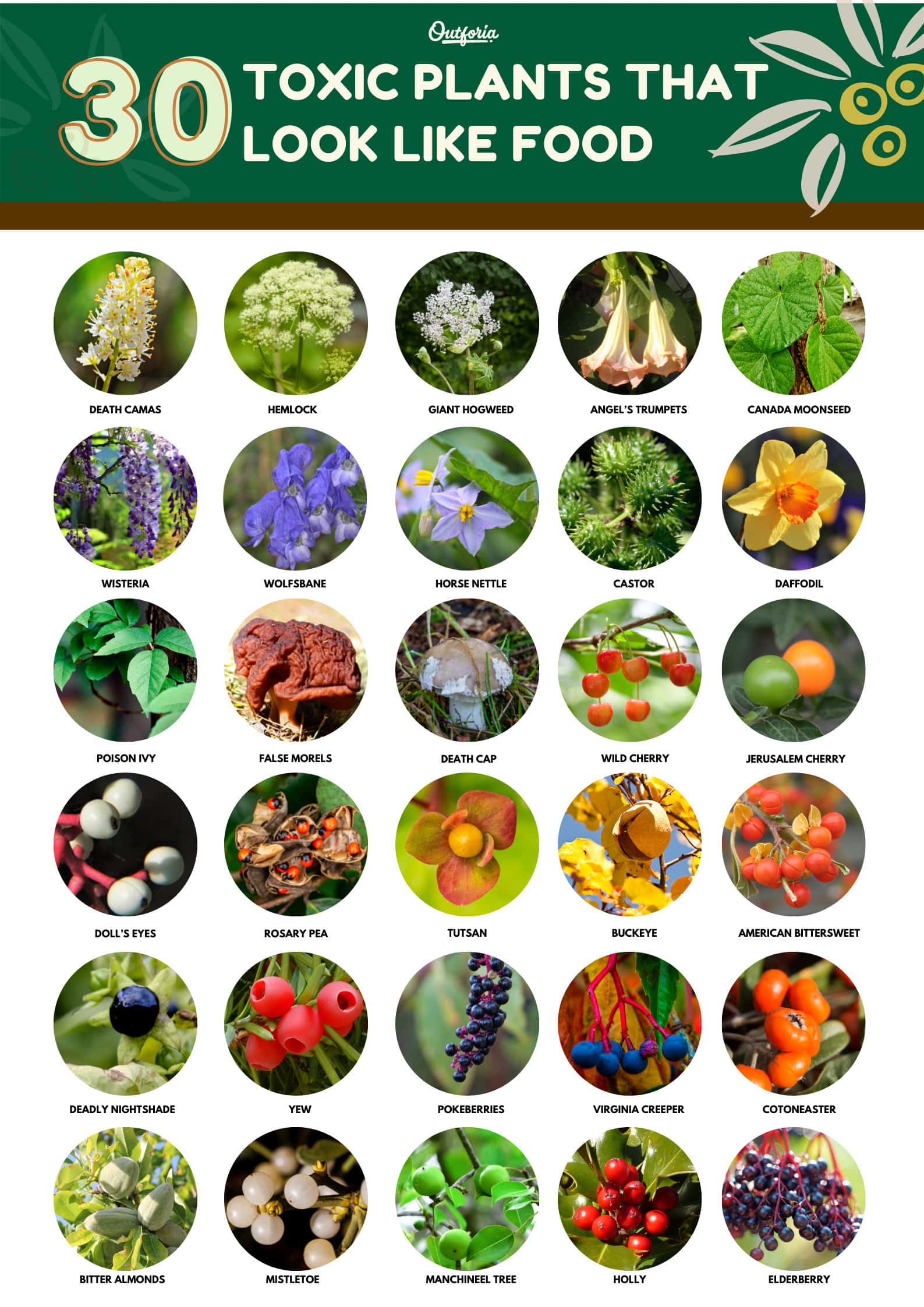
<a href="https://outforia.com/toxic-plants/"><img style="width:100%;" src="https://outforia.com/wp-content/uploads/2021/07/30-Toxic-Plants-Backcountry-1.jpg"></a><br> Toxic Plants Infographic by <a href="https://outforia.com">Outforia</a> 
Caution! Foraging Safety
Before we get to our list of poisonous berries, herbs, and other plants, we have to talk about foraging safety.
In reality, there's no universal way to identify if a plant is edible or toxic. This means that anyone who wants to go foraging needs to be very comfortable with plant identification.
This article is designed to give you only an overview of some of the most common poisonous plants. But it's a big world out there and we couldn't possibly list everything here. As a result, you need to rely on your personal plant identification skills to decide if a berry, leaf, or mushroom is okay to eat.
At the end of the day, the best thing to do is to play things safe. Enroll in a foraging course or buy a field guide, such as Foraging for Survival: Edible Wild Plants of North America, if you want more detailed guidance.
Otherwise, if you aren't 100% sure that a plant is edible—don't eat it. You'd be better off missing a meal than getting very ill.
This guide is for informational purposes only and shouldn't be used as your sole source of identification.
30 Toxic Plants That Look Like Food: What You Need To Know
1. Death Camas
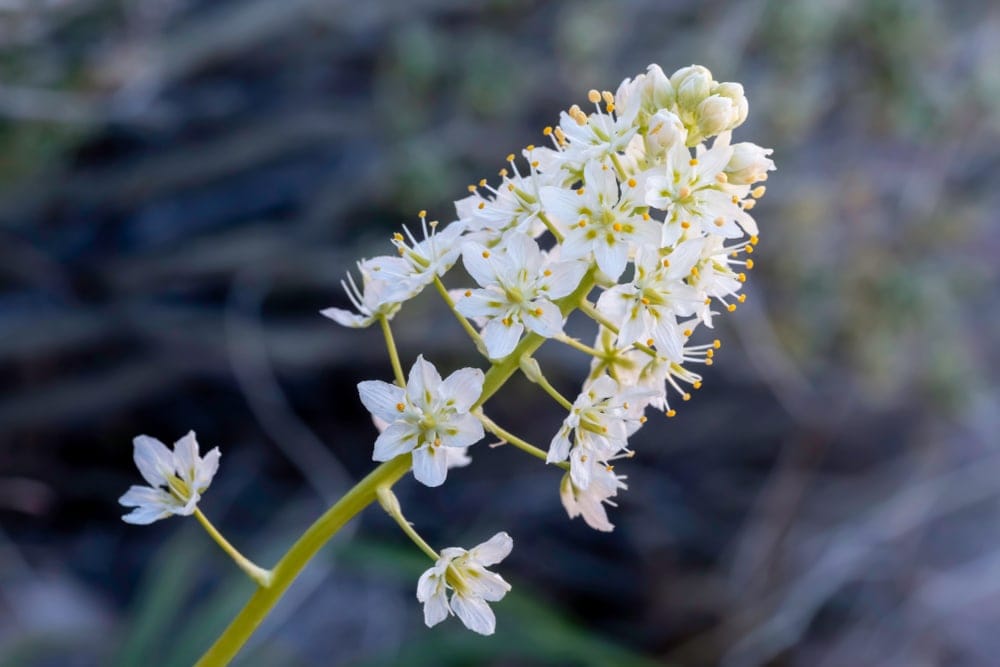
If a name like "death camas" doesn't tell you to stay clear of this plant, nothing will. All jokes aside, however, death camas (Zigadenus venenosus) is one of the most toxic plants in North America.
Death camas is found throughout the western and midwestern United States and it looks like a tall, grass-like plant. Below the ground, it has a sizable bulb that makes it look dangerously similar to plants like onions, garlic, leeks, chives, and scallions.
The problem is that, unlike these plants, death camas is not edible. It can cause muscle weakness, vomiting, tremors, convulsions, and, as its name suggests, death. Thankfully, poisoning among humans isn't very common, but death camas is known to cause problems for livestock, especially sheep.
Either way, death camas is one toxic plant that you should avoid at all costs.
2. Jerusalem Cherry
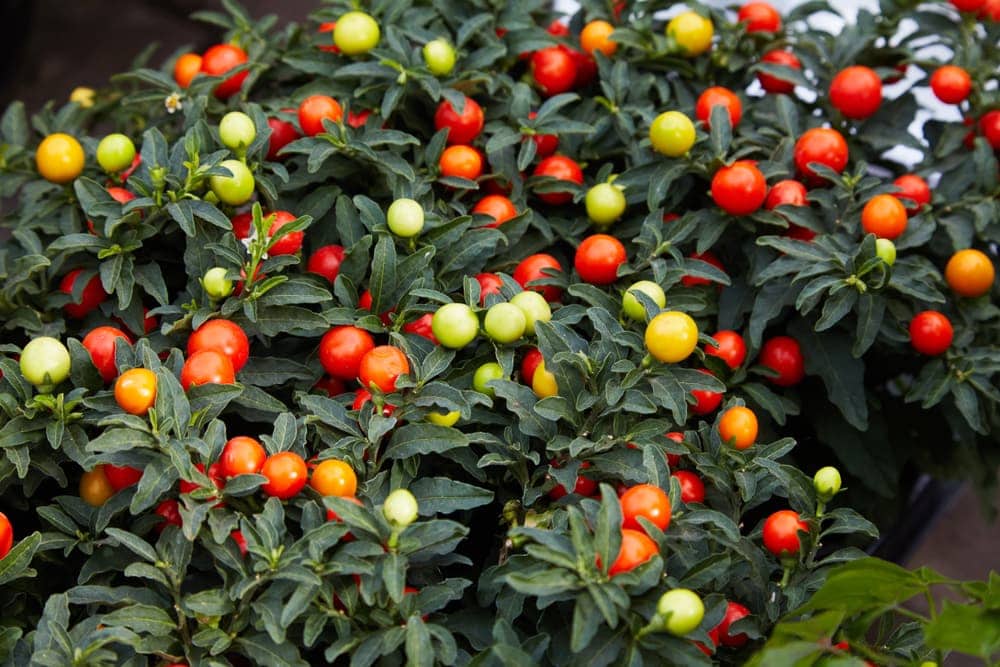
Jerusalem cherry (Solanum pseudocapsicum) is a nightshade that's traditionally used as an ornamental plant for Christmas. However, while it makes for a pretty decoration, the fruits and seeds of the Jerusalem cherry are highly toxic.
In fact, the poisonous fruit of the Jerusalem cherry contains solanocapsine. Unless eaten in very large quantities, solanocapsine usually isn't deadly to humans, but it can cause gastrointestinal problems and severe vomiting. It's also possible that these berries are poisonous to cats, but more research is needed to confirm that.
The problem is that the fruit of the Jerusalem cherry is a small, reddish-orange cherry tomato-looking fruit. This can make it difficult to identify, particularly because there are so many varieties of this plant. Therefore, it's generally best to avoid plants that look like cherry tomatoes while foraging in the wild.
3. Doll's Eyes
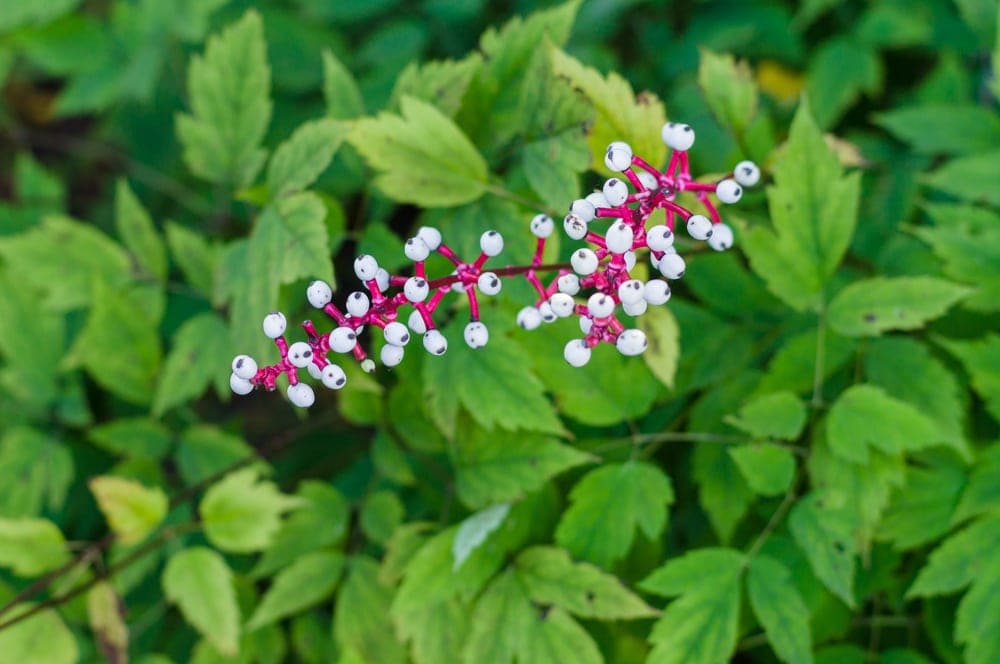
If there's one plant that you need to avoid at all costs, it's this one: doll's eyes (Actaea pachypoda). A member of the buttercup family, doll's eyes look like innocuous white flowers before they become raisin-sized white berries with a distinctive black spot.
These berries can be found throughout the deciduous woodlands of eastern North America, and they are highly toxic. The plant contains an as-of-yet unidentified toxin that affects the cardiac system. This toxin is found throughout the plant, including in the roots and berries. When ingested, this toxin effectively "sedates" the heart and can lead to immediate cardiac arrest.
Thankfully, you need to eat a fairly large amount of these berries for this to happen, which isn't likely because the berries are so bitter. But, the doll's eyes are best to avoid on the trail.
4. Hemlock
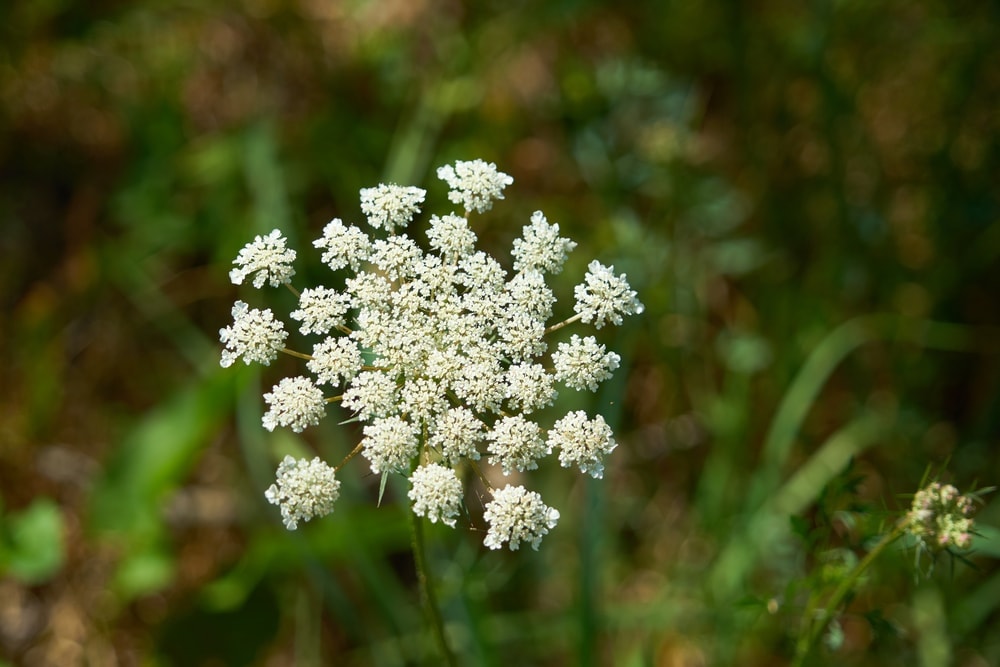
Although the word "hemlock" is used to describe a number of types of harmless trees, there is a completely different type of hemlock that you ought to avoid, namely the poison hemlock (Conium maculatum).
Poison hemlock is found throughout Europe and North America and it's part of the carrot family. Unlike your standard garden variety carrot, however, poison hemlock is, well, poisonous.
The entirety of the poison hemlock plant is toxic, though the roots and the seeds are the biggest causes of concern. This plant can grow to be upward of 8 feet (240 cm) tall and it has a very strong, unpleasant odor.
There are a number of toxins within poison hemlock, though coniine and other similar alkaloids are the most dangerous to us humans and all other mammals. These alkaloids can lead to respiratory failure, though rapid medical intervention can often prevent death from hemlock poisoning.
Keep in mind that the poisonous hemlock looks a lot like the wild carrot. However, wild carrots have purple markings and hairs on their stems, which the hemlock does not. Also, the wild carrot is usually substantially smaller than the poisonous hemlock. But, when in doubt with this plant, it's better to be safe than sorry.
5. Rosary Pea
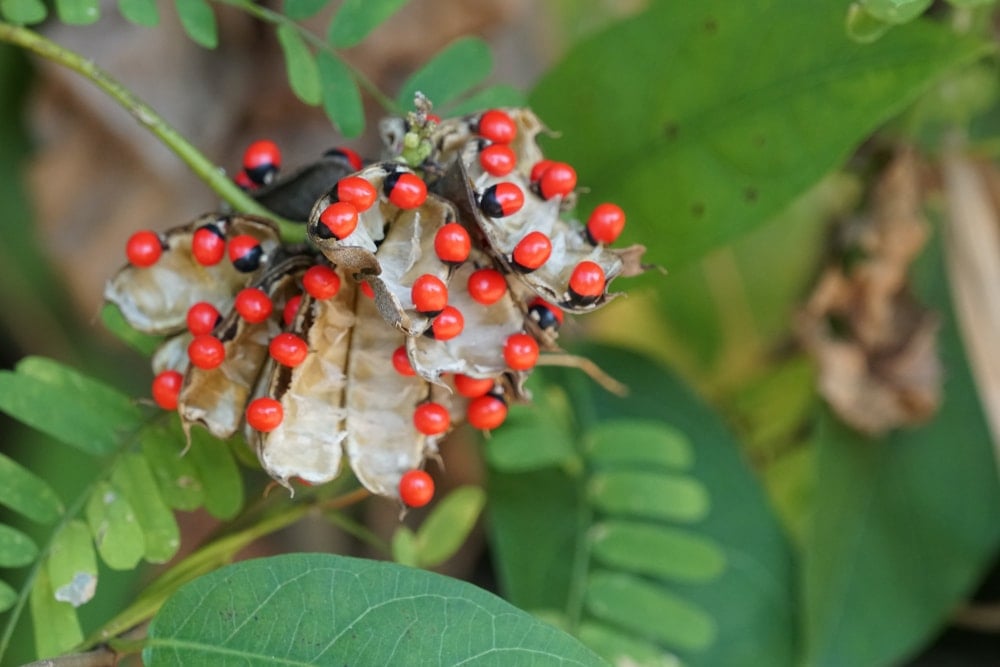
Rosary peas, or jequirity beans (Abrus precatorius), are a small flowering plant that's technically native to Asia and Australia. However, it has since been introduced around the world and it is now found throughout sub-Saharan Africa, southern North America, Central America, South America, and Oceania.
This plant features bright red seeds that have a red spot, though there are some varieties that have a black seed and a white dot. Either way, all varieties of the rosary pea have a toxin known as abrin, which is a natural poison that can cause multisystem organ failure and eventually death.
Interestingly, albrin is actually being researched for potential use as a cancer-treating drug. That's because abrin works by invading the cells in your body and preventing them from making proteins. Doing so stops the cells from reproducing, which is one of the primary issues with cancer cells. The hope is that abrin can kill cancer cells without affecting healthy cells.
Despite its potential medical benefits, however, rosary peas and abrin are best avoided. Technically, you could be exposed to abrin just by touching the plant, so avoid handling rosary peas whenever possible.
6. Giant Hogweed
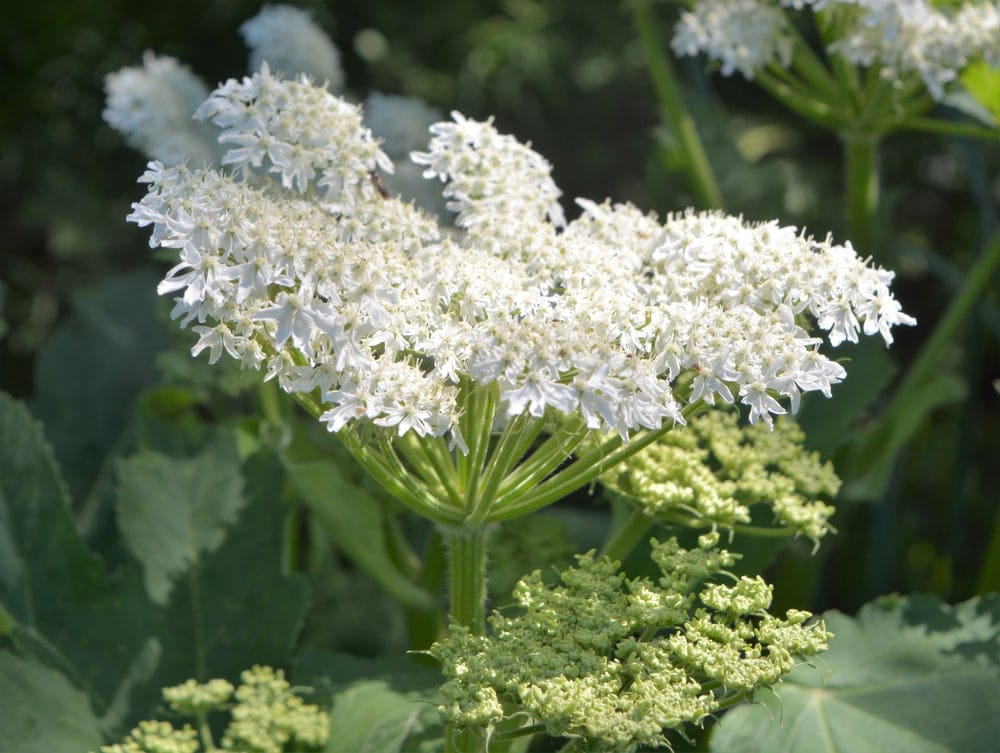
One of the most infamous invasive species in North America, the giant hogweed (Heracleum mantegazzianum) is a plant that can cause poisoning and serious skin irritation. The plant is originally from the western Caucasus region, however, it has since been introduced to the United Kingdom and North America, where it is highly invasive.
As the plant's name suggests, giant hogweed is truly gigantic. It can grow to massive proportions of up to 14 feet (4.2 m) and it can have leaves that are up to 5 feet (1.5 m) wide. If that's not intimidating, we don't know what is.
In addition to being a federally listed noxious weed for its high toxicity when consumed, giant hogweed can cause serious health issues just through physical contact. That's because the plant has something called a phototoxic, which is a sap on its leaves and stalk that can cause burns and permanent scarring when it comes into contact with sunlight. Yikes!
In many parts of North America, there are campaigns to eliminate giant hogweed due to the invasive species' potential dangers. If you do come into contact with giant hogweed, stay out of the sunlight and call your physician immediately for more guidance. If you have giant hogweed on your property, consider contacting local officials for help with removal.
7. Death Cap
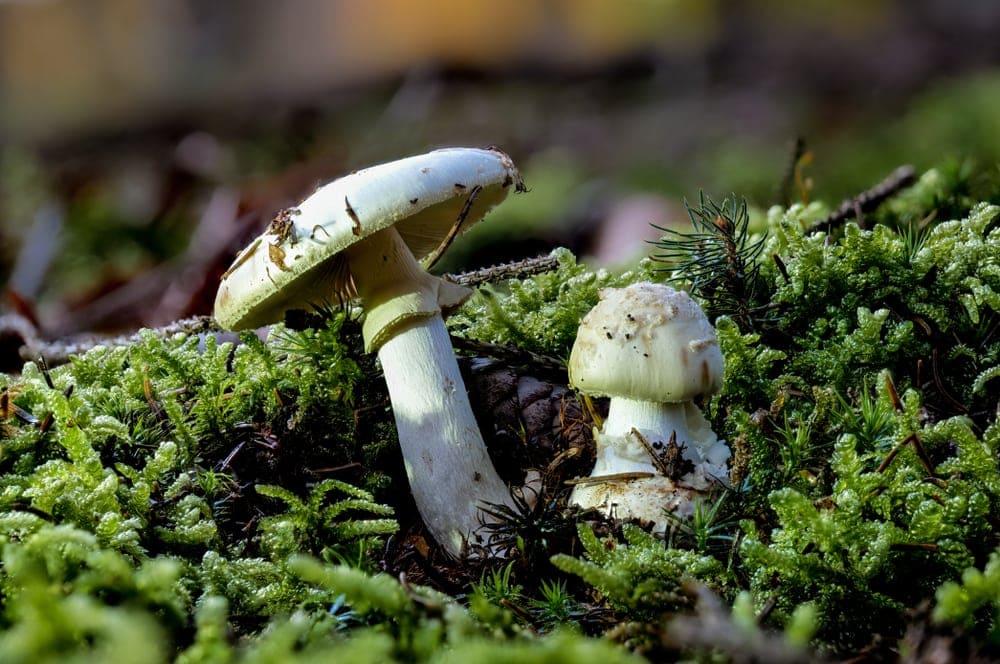
Yet another plant whose name lets you know that you should stay well away, the death cap (Amanita phalloides) is one of the world's most infamous mushrooms. Okay, well, technically, mushrooms are fungi—not plants—but the severe danger of this mushroom (and a few others) warrants their inclusion on our list of poisonous herbs, berries, and leaves.
The problem with the death cap, which is a small white mushroom, is that it's easily mistaken for other edible types of mushrooms like Caesar's mushrooms and straw mushrooms.
Unlike these other fungi, however, the death cap contains amatoxins, which can fatally damage the liver. In fact, just a small bite of this mushroom could be deadly and the toxin in the fungi persists, even when cooked.
The death cap is often blamed for fungi-related deaths because it's so difficult to identify. So, as with most edible plants and fungi, if you're not 100% sure that a small white mushroom is safe to eat, just leave it where it is and continue down the trail.
8. Angel's Trumpets
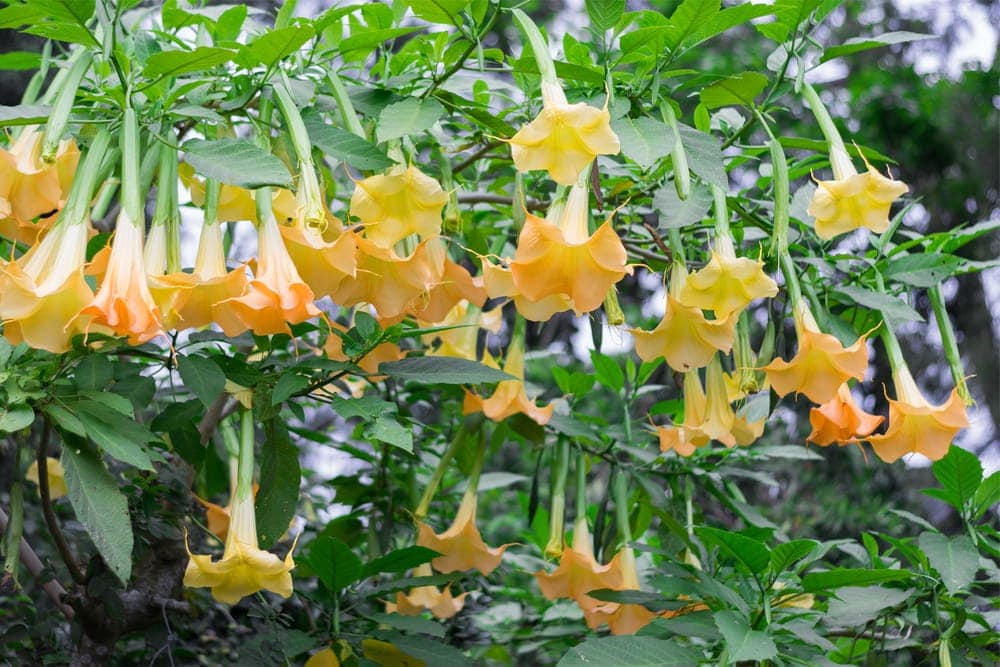
Although there are plenty of fantastic edible flowers out there, the angel's trumpet (Brugmansia species) is not one of them.
This flower is native to the Andes in South America but it has since spread to various parts of the Americas. It grows on a woody shrub with large leaves and the flowers hang down from the plant's thick stems. These flowers vary in color from orange to yellow, so they're popular ornamental plants.
The problem is that the various species of angel's trumpets are all highly toxic. They contain tropane alkaloids, which, when consumed, act as antagonists to the autonomic nervous system. This might sound like a bunch of medical mumbo jumbo but the point is that these flowers can lead to muscle weakness, gastrointestinal illness, and even respiratory failure.
Interestingly, the angel's trumpet was once used as a hallucinogen, however, its toxicity makes it a very risky thing to consume. Our advice? Stay away from the angel's trumpet or any other plant that looks like it.
9. Tutsan
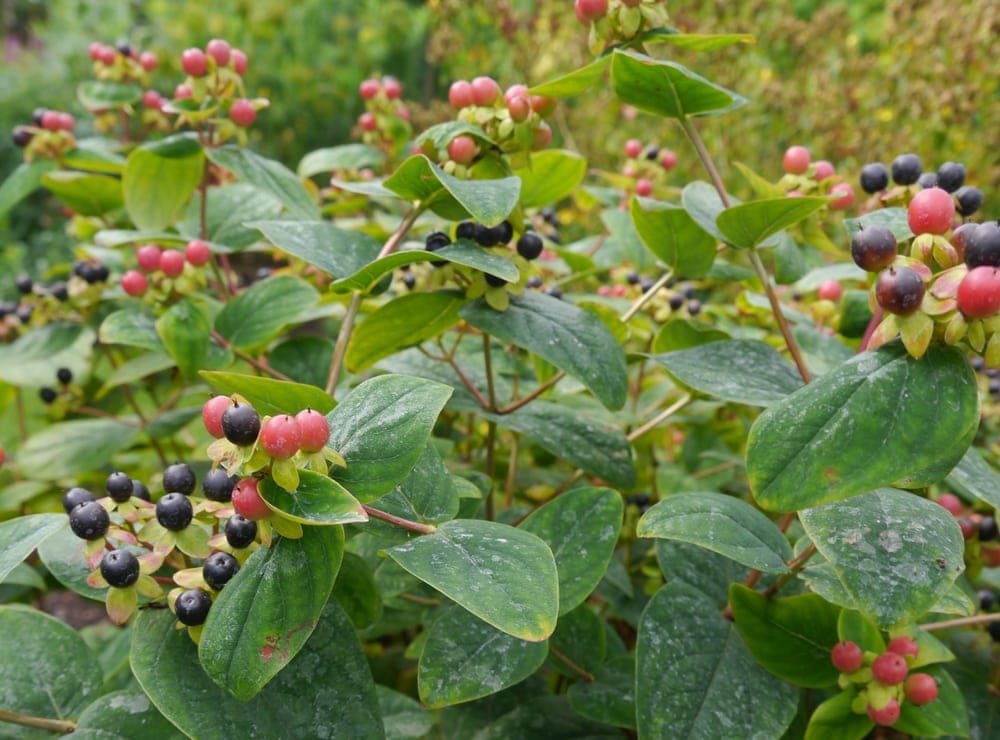
Traditionally used to ward off evil spirits, the tutsan (Hypericum androsaemum) is a perennial shrub that's native to Eurasia. It was traditionally used as a medicinal plant for things like antidepressants.
However, despite its historic medicinal use, the entire tutsan plant, including its berries, which look similar to blueberries in some situations, are toxic. That's because they contain hypericin, which is a commonly found compound in species of the St. John's Wort genus (Hypericum).
It's unclear precisely what it is about hypericin that's toxic, but it's believed that this compound can lead to cell death. Nevertheless, consuming tutsan berries can lead to nausea and diarrhea, so it's perhaps not the best option for your trail snack.
10. Canada Moonseed
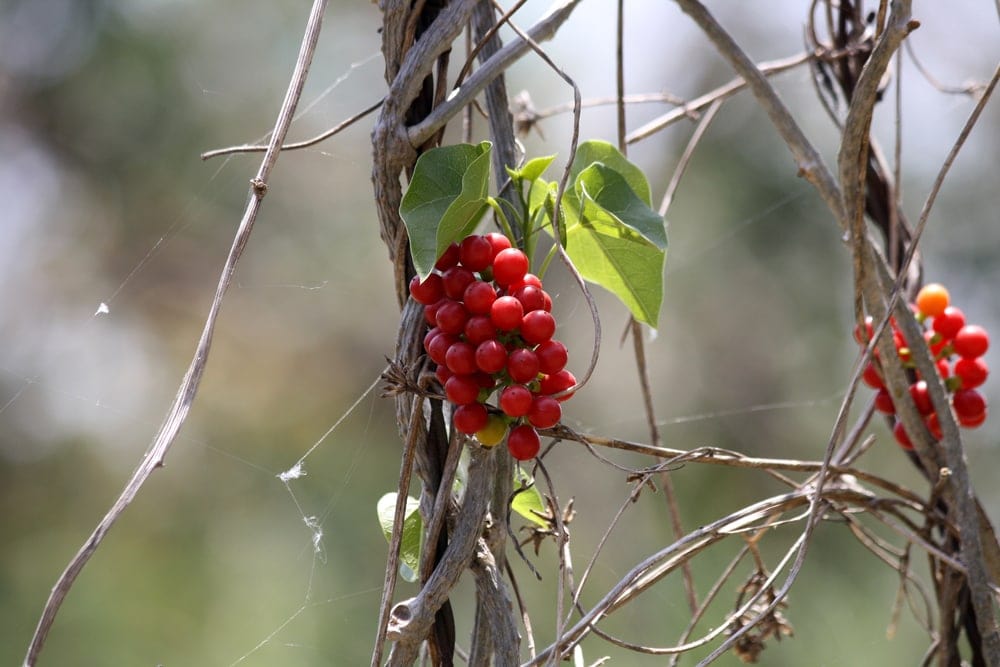
Canada moonseed (Menispermum canadense), or simply common moonseed, is a highly toxic plant that's found throughout eastern North America. It is a relatively small flowering plant that forms in thickets with thick green leaves and small bunches of blueberries.
Although it might look like any other berry-bearing plant, the Canada moonseed is exceptionally toxic. It contains a plant metabolite called dauricine, which is found throughout the plant's berries, roots, leaves, and flowers. Dauricine causes cardiac issues that can lead to cardiac arrest and death. Needless to say, don't eat the Canada moonseed.
Interestingly enough, however, this highly toxic compound is being studied for use as a cancer treatment because there's some hope that it can suppress the growth of cancer cells. One 2019 study found that it was fairly successful at suppressing pancreatic cancer growth in mice. Even still, don't eat Canada moonseed.
11. Buckeye
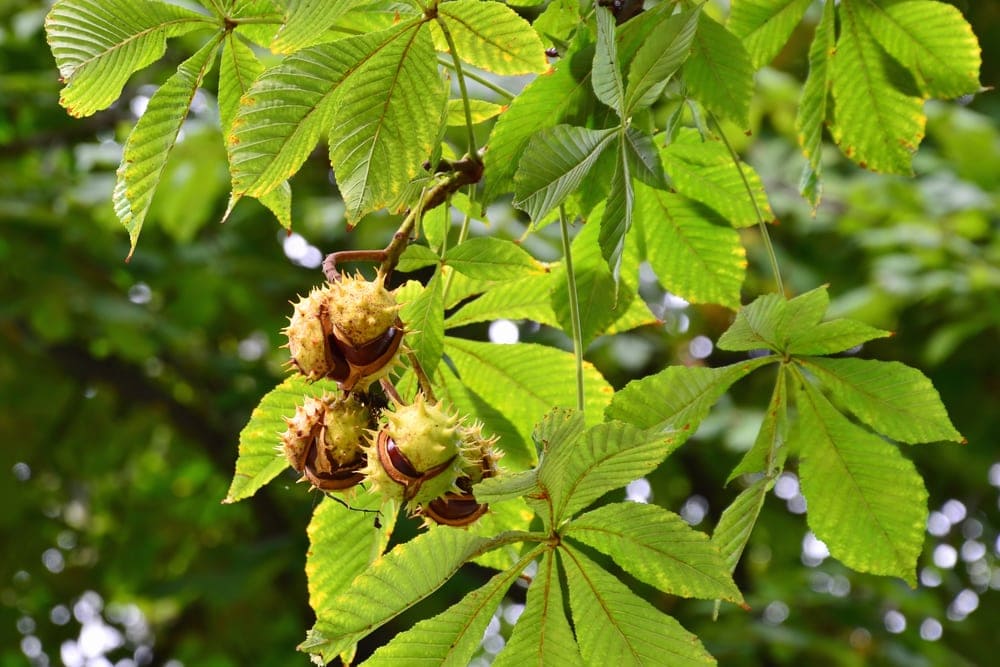
Also known as the horse chestnut, the buckeye is a tree in the Aesculus genus that's known to be highly toxic. It is a popular ornamental shade tree in dry locations, though it's generally found in relatively moist environments in North America and Eurasia.
The buckeye tree is pretty to look at and, in fact, it's even the state tree of Ohio. However, the various buckeye species contain a number of compounds, such as the glycosides aesculin and fraxin, that are known to be toxic.
Toxicity from the buckeye plant is most common in cattle and other livestock that eat the nuts that fall from the buckeye tree. But, these nuts are just as toxic to humans, so they should be avoided, even though they may strongly resemble other types of edible chestnuts.
12. Wisteria
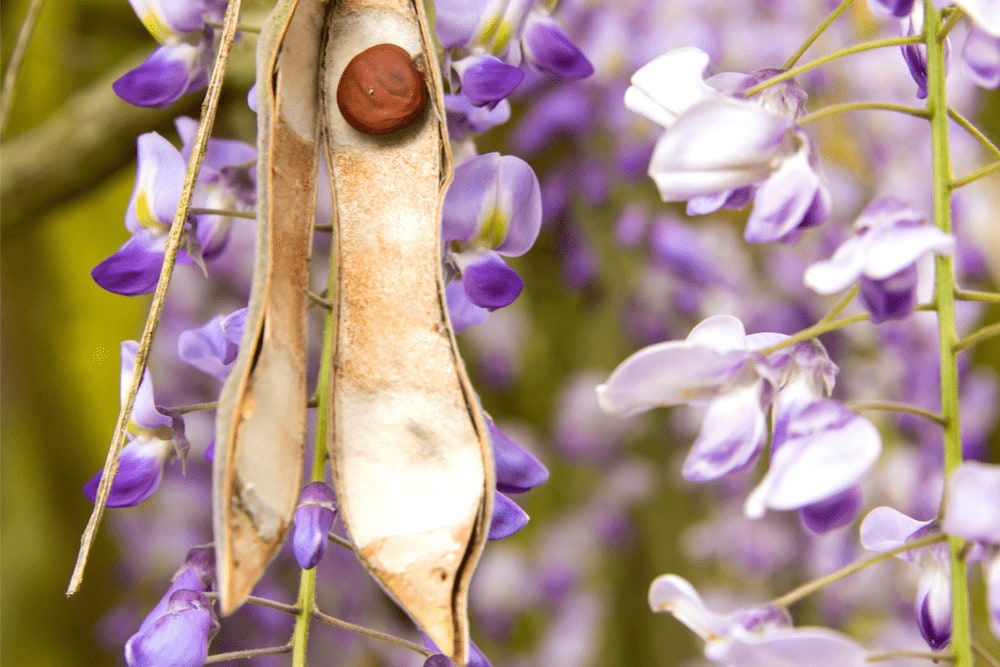
Wisteria is one of the most beautiful and iconic flowering plants. But when it comes to finding tasty snacks on the trail, the beautiful purple seed pods of the wisteria plant should not be at the top of your list.
Technically speaking Wisteria is the name of a genus of climbing vines that create beautiful purple and blue flowers. These plants hold their seeds in hanging seed pods, all of which are highly toxic.
The primary toxic compounds in wisteria are lectin and wisterin, both of which can cause signs and symptoms like diarrhea, vomiting, burning sensations, and stomach pain. Ultimately, while wisteria is a gorgeous ornamental plant to have around your home or to see on the trail, it's one of those plants that are nice to look at but that doesn't make for a great treat.
13. False Morels
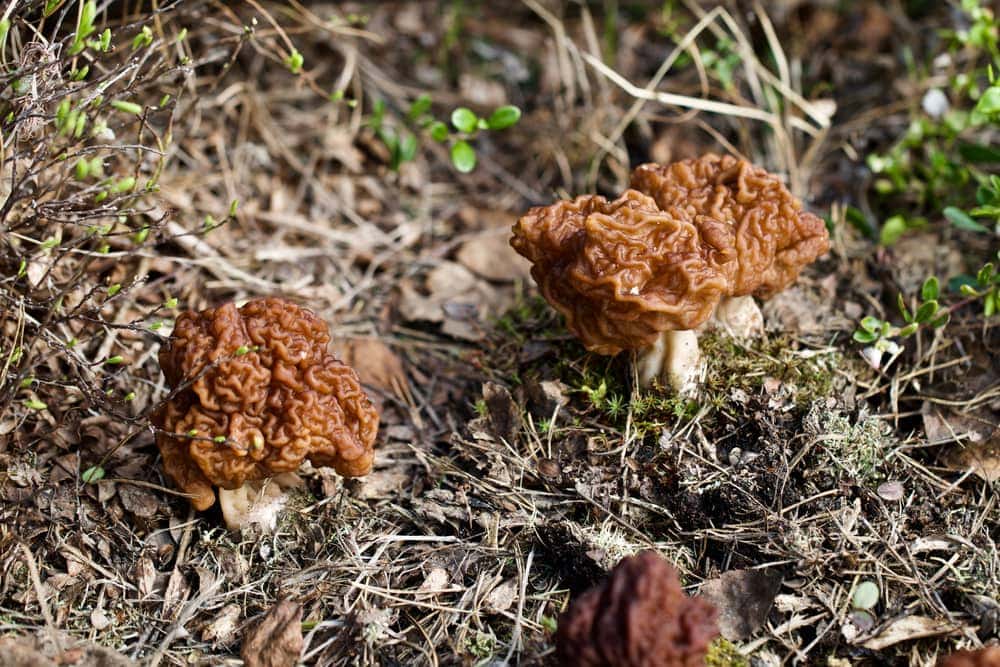
Morels are some of the tastiest mushrooms out there, but their look-alikes, the false morels, are highly toxic. The name false morel refers to a collection of different mushrooms, like Gyromitra esculenta and Gyromitra caroliniana, which bear a similar shape and structure to the true morel but that also have toxic compounds.
Depending on what species you eat, consuming a false morel could lead to gastrointestinal issues, muscle coordination problems, and even cardiac arrest. This is because false morels usually contain gyromitrin, which is a type of toxin that affects the cardiac system.
The issue is that distinguishing between true and false morels in the wild isn't easy. Each species of false morel can have different physical features, some of which look exceptionally similar to true morels.
Moral of the story? Consult a field guide or a foraging expert before collecting morels. That way, you can be more confident in your ability to harvest the non-toxic true morel.
14. Wolfsbane
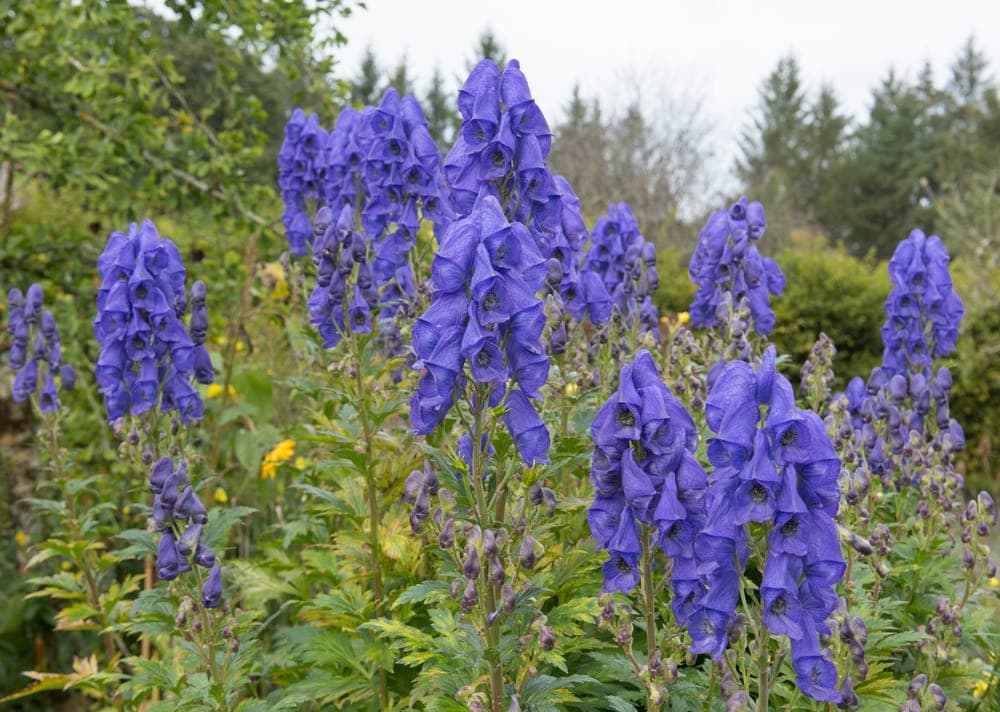
Also known as monkshood, wolfsbane (Aconitum napellus) is one of the most infamous poisonous plants on the planet. Wolfsbane is found in temperate regions throughout Europe and North America and it is one of the most toxic flowers in these two regions.
In fact, wolfsbane was once used as a poison against large carnivores, such as wolves, which is how it got its name. It's also believed that wolfsbane was used in a number of Indigenous cultures in North America to poison arrowheads.
The danger with wolfsbane is its active chemical, aconitine, which is found throughout the plant. Aconitine affects the functioning of sodium channels in nerves, which prevents them from functioning properly. Even a small amount of aconitine can lead to paralysis and eventually death.
Furthermore, while consuming wolfsbane is the most likely cause of toxicity with this plant, even touching it could cause symptoms of toxicity. Usually, these effects aren't as severe as they would be if you consumed wolfsbane, but it's still best to avoid handling these distinctive dark purple flowers.
15. Horse Nettle
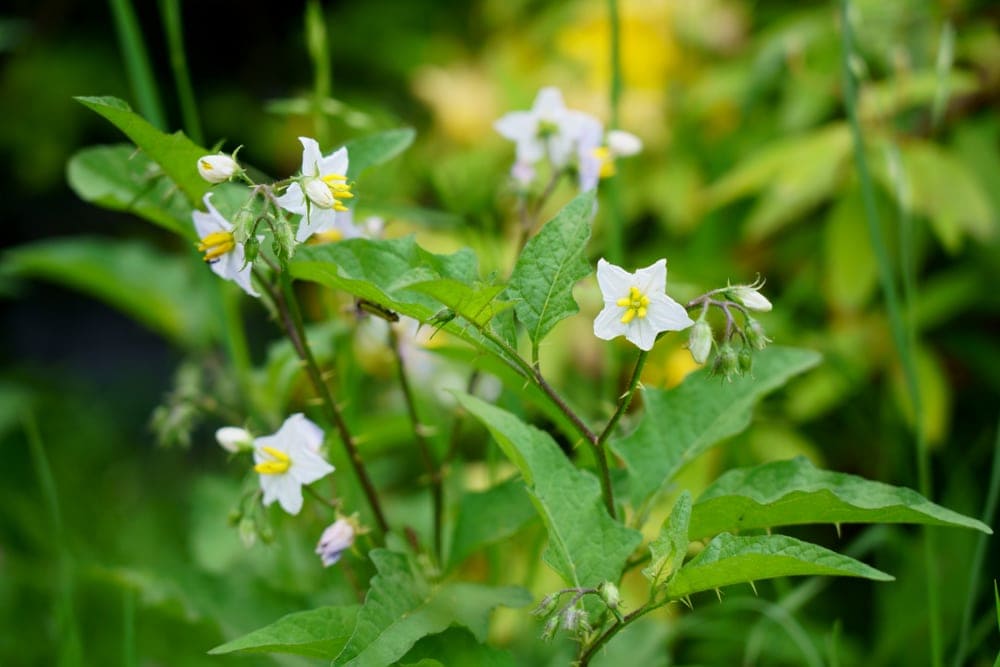
Despite its name, horse nettle (Solanum carolinense) is not actually a nettle, but rather it is a type of nightshade.
Horse nettle is a type of herbaceous plant that grows large leaves and has white and yellow star-shaped flowers. It is most commonly found in temperate North America, but you can also find it in areas of Europe, Australia, and temperate Asia.
Also called devil's tomato, the horse nettle is well-known for bearing a highly toxic tomato-like fruit. This poisonous fruit contains solanine, which is a type of alkaloid that can cause abdominal pain, vomiting, nausea, and even respiratory arrest. When eaten in large quantities, horse nettle can even cause death.
Since the fruit of the horse nettle does look a lot like a cherry tomato, it's important to be careful when picking tomato-like fruits in the wild. Keep in mind that the horse nettle has a thorny stem, which is one way that you can tell the two apart. However, caution is still necessary whenever picking tomato-like fruits on the trail.
16. Castor
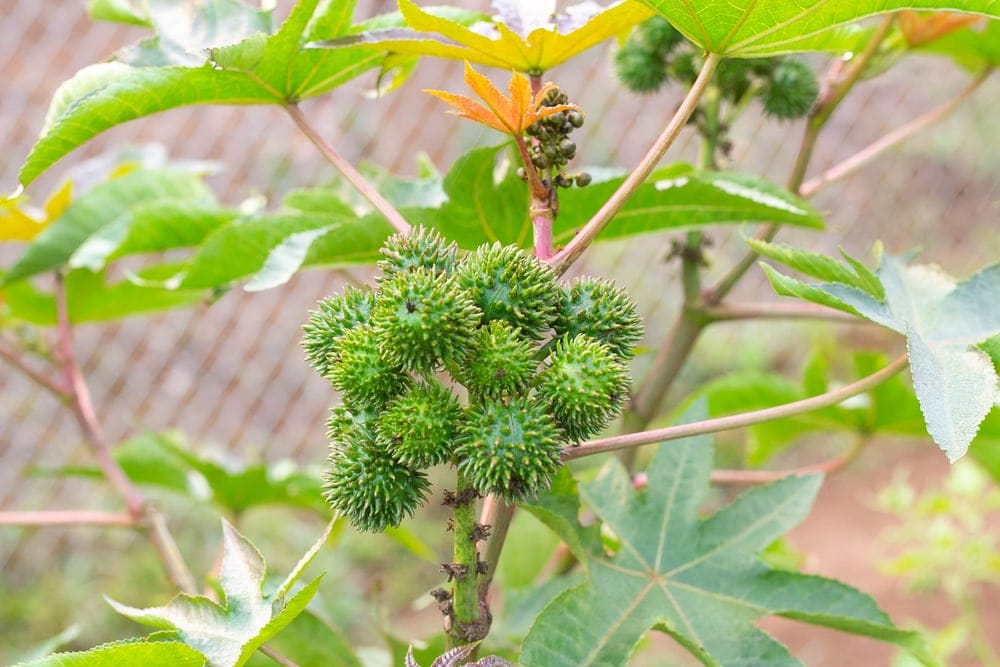
Castor (Ricinus communis) is a type of flowering plant that's arguably best known for the castor bean, which is technically a seed. The castor bean is used to create castor oil, which is used for manufacturing dozens of products, from paints to perfumes.
This plant is traditionally found throughout the Mediterranean Basin, the Indian subcontinent, and eastern Africa, though it's now spread throughout the tropics and subtropics.
Although castor bean oil is a very popular manufacturing product and even though the castor bean looks like it might be edible, it's actually highly toxic. This is because raw castor beans have a high level of ricin, which is a type of poison that prevents cells from making proteins.
Thankfully, castor bean poisoning isn't that common, but it is possible, particularly if you eat a large number of castor beans. It's estimated that a healthy adult would need to eat approximately 4 to 8 castor beans in order to get seriously ill.
But since the ricin in castor beans could kill you, it's probably best to avoid eating castor beans, regardless of the quantity you consume.
17. American Bittersweet
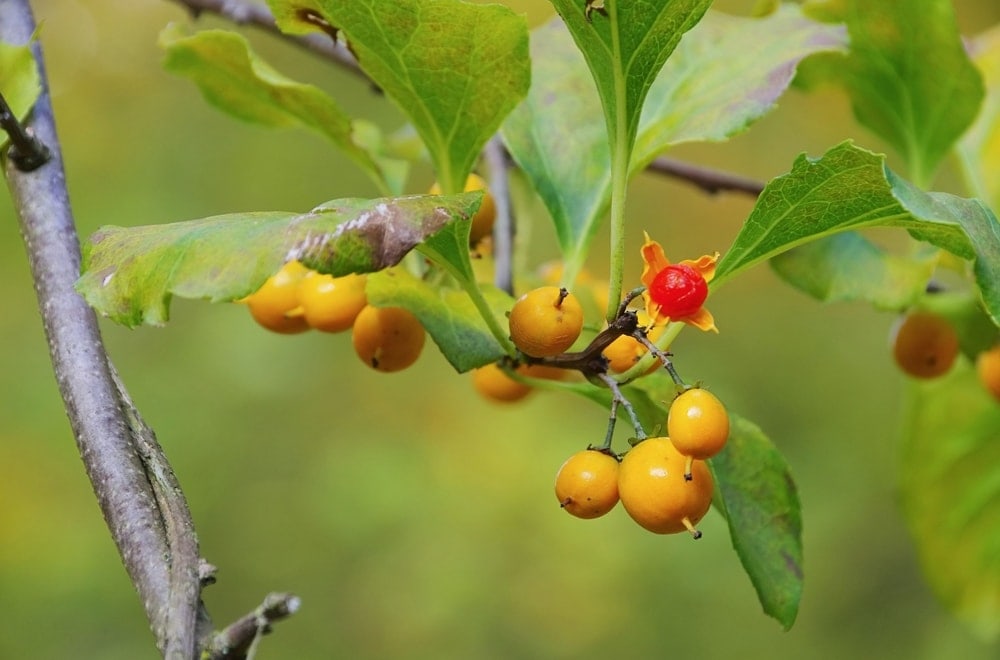
American bittersweet (Celastrus scandens) is a fairly common type of twining vine that is found climbing its way up trees, fences, trellises, and other structures throughout deciduous ecosystems in North America.
It has small oval-shaped leaves and small flowers that form in clusters. Eventually, these flowers give way to small orange or red-colored fruits.
However, the American bittersweet has a bit of a controversial history of toxicity. While some sources maintain that the American bittersweet is not toxic to humans, it's been suggested that the plant's fruit was used by a number of Indigenous communities to induce vomiting.
Either way, we do know that American bittersweet is highly toxic to dogs, cats, and horses. So, if you're adventuring with your pet or pack stock in tow, be mindful of these potentially dangerous fruits on the trail.
18. Daffodil
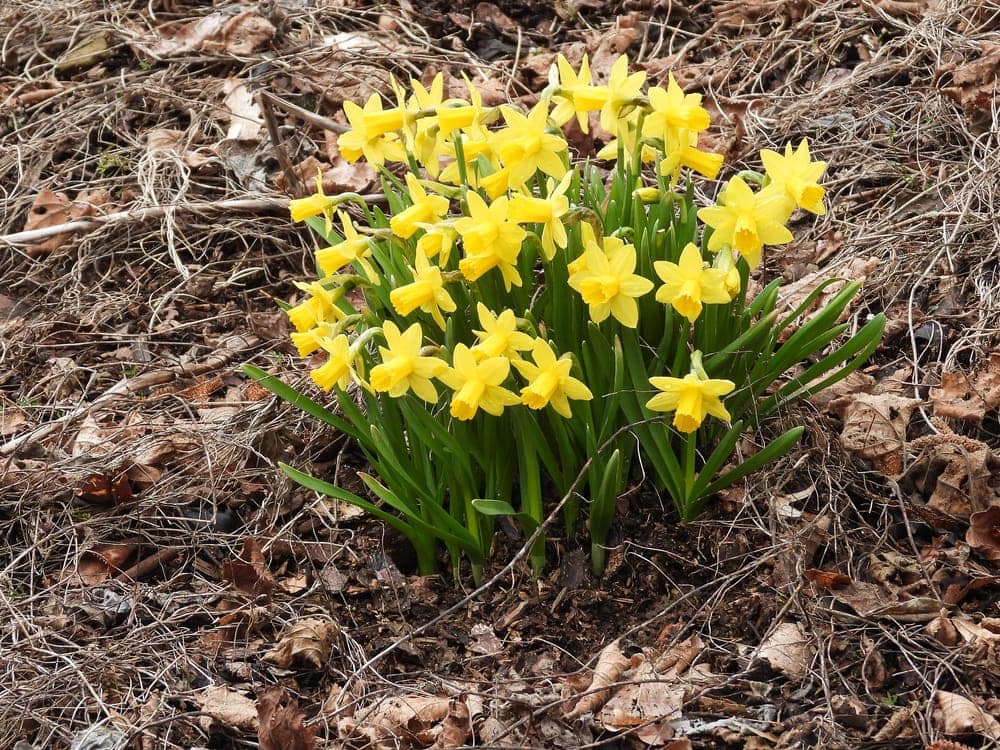
Daffodils are a common sight around manicured gardens and in the wilderness during the spring months. However, they are not a good trail snack because they are highly toxic.
All daffodil varieties contain a chemical called lycorine, which is present throughout the plant's flower, stem, and bulb. In fact, the bulb of the daffodil has the highest concentration of lycorine, which is known to cause nausea, abdominal pain, and even liver damage.
Since daffodils are so distinctive when in bloom, it's unlikely that someone would mistake them for a different kind of edible flower. The problem with daffodils arises before they bloom. Because daffodil bulbs can look like wild onions, some people have mistaken them for onions, which is problematic.
Thankfully, there is a way to tell daffodil bulbs and onions apart. First and foremost, daffodil bulbs don't smell like onions. But, even in the absence of this olfactory clue, daffodil bulbs also don't tear into layers like onions do. So, proper identification is key when searching for wild onions.
19. Deadly Nightshade
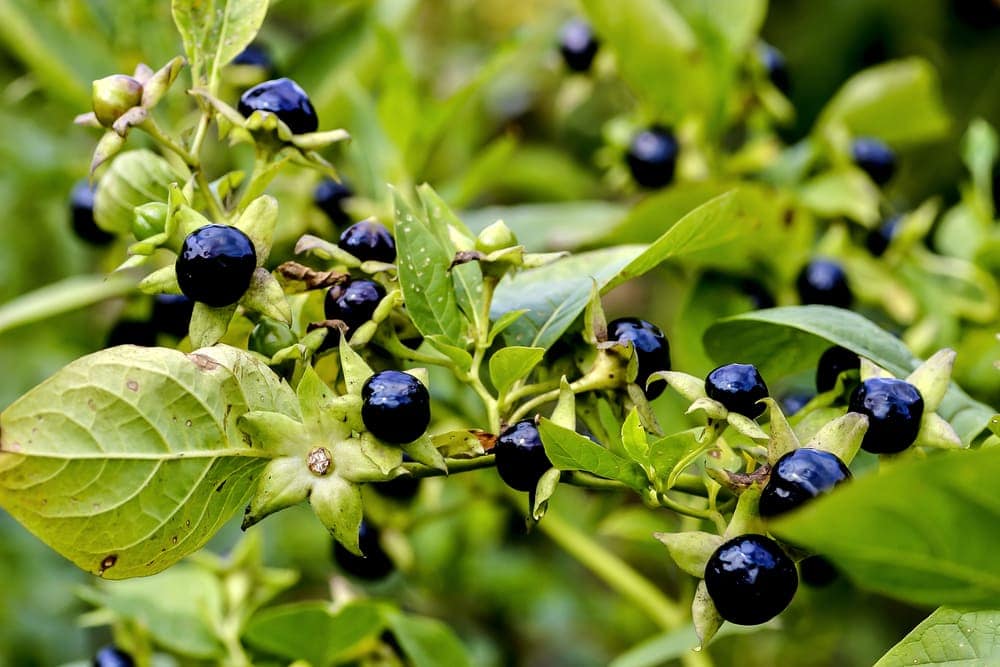
Another aptly named plant, the deadly nightshade (Atropa belladonna), or devil's cherries, is a type of poisonous herbaceous plant in the nightshade family. This plant originated in southern Europe and Asia, but it has since been introduced to the Americans and other parts of the world.
The toxic properties of this plant have been known for countless generations. Its leaves and black berries contain tropane alkaloids, which are also found in angel's trumpets. These alkaloids are known hallucinogens but they can also cause respiratory failure when consumed in a large enough quantity.
Unfortunately, deadly nightshade looks a lot like black nightshade, which is edible. The toxic berries of deadly nightshade also taste fairly sweet and they look like they might be edible. As a result, careful plant identification is of the utmost importance when working with nightshades.
20. Yew
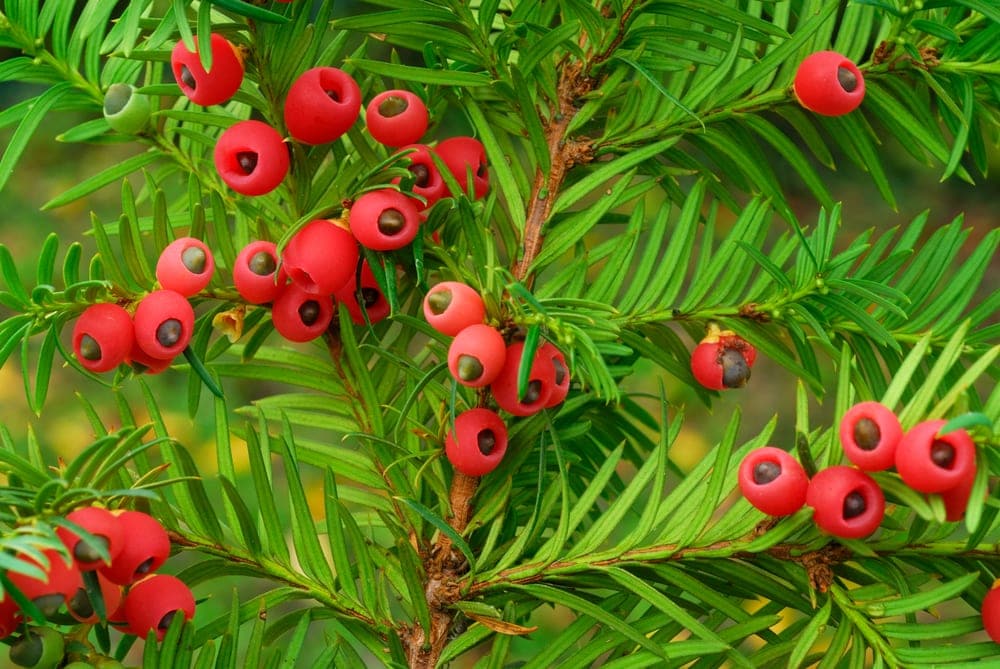
One of the most iconic trees in the British Isles and western Europe, the yew (Taxus baccata) is a species of evergreen tree that's often grown as an ornamental plant. There are many other species of yew, including the American yew and western yew, that are also toxic to humans and animals, alike.
There is a long history of documentation of the toxicity of the yew tree. We now know that the yew contains taxine alkaloids, which work as antagonists in the nervous system that can lead to cardiac arrest. Consuming yew can be deadly, even in relatively small quantities, depending on the size of the person or animal in question.
Interestingly enough, the red flesh cup (called an aril) of the yew is technically edible. However, the yew seeds (technically a stone) are very toxic, as are the leaves of the yew tree. Therefore, it's generally best to not consume any part of the yew tree as inadvertently eating the leaves or seeds could have severe consequences.
21. Pokeberries
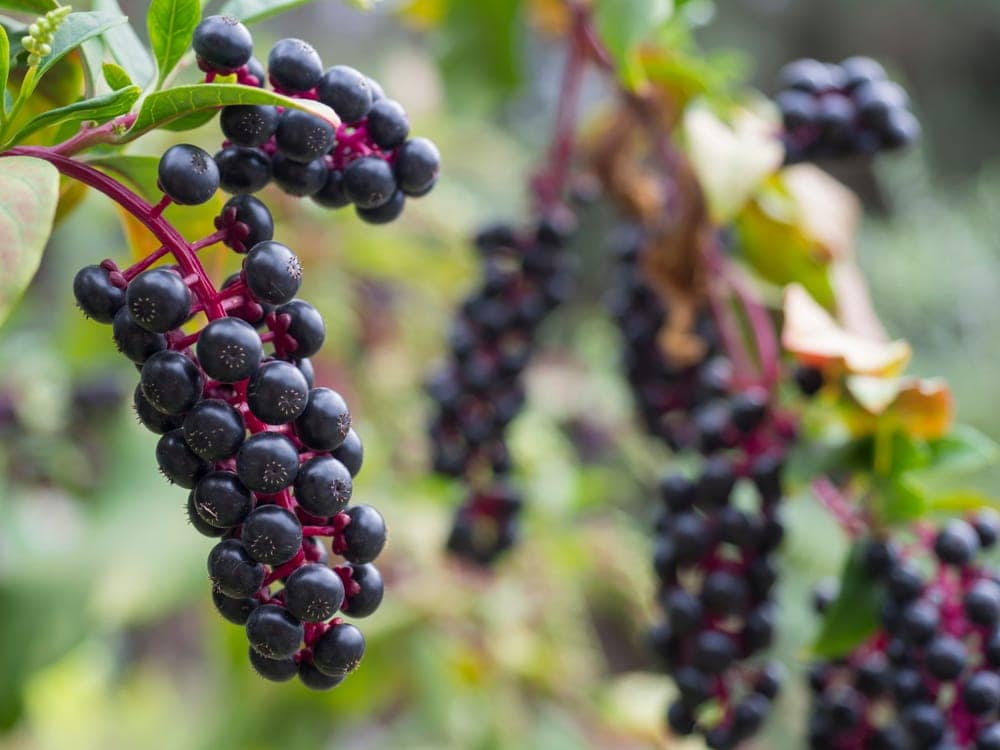
Also known as pokeweed, pokeberries (Phytolacca americana) are an herbaceous plant that can be found in forested and prairie regions throughout eastern Canada and the entirety of the continental US, except for the Rocky Mountain states.
These plants usually grow to be about 6 to 10 feet (1.8 to 3 m) tall and they feature thick, rigid stems that bear clusters of pink flowers. The entirety of the pokeberry plant is poisonous as the plant contains a number of toxins.
The berries of the pokeberry plant are especially poisonous and they can cause severe illness or death. Unfortunately, the berries of the pokeberry plant do roughly resemble a bunch of grapes, which makes them a danger to unsuspecting young children. This means that extra caution is needed when hiking in pokeberry habitat with young adventurers.
22. Virginia Creeper
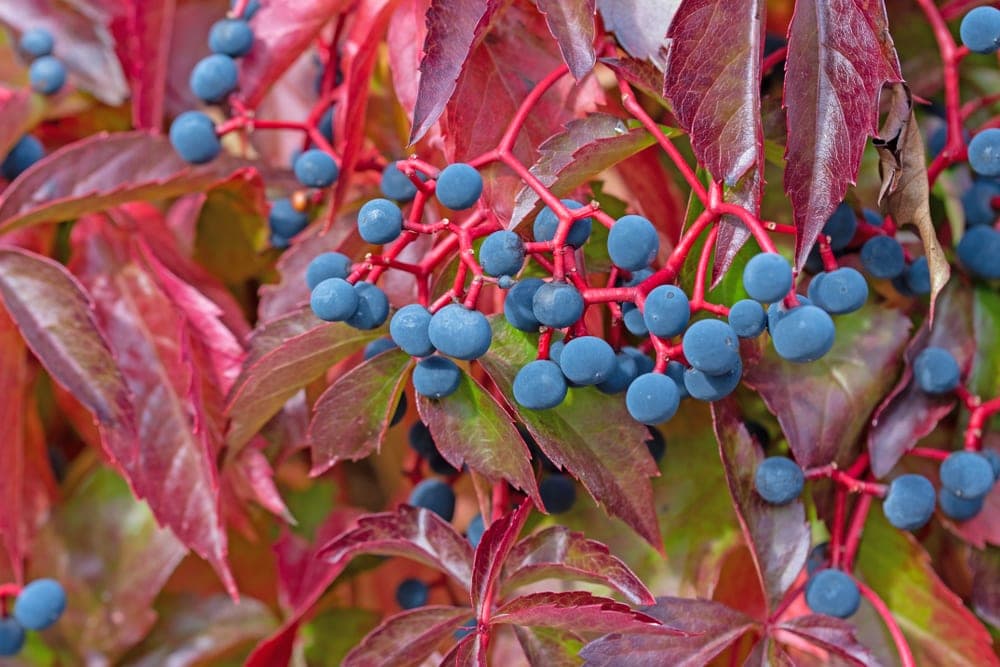
Sometimes called the five-leaved ivy, the Virginia creeper (Parthenocissus quinquefolia) is a type of decorative ivy that's originally from the eastern and central parts of North America. Although it can sometimes be confused with poison ivy, Virginia creeper has clusters of five leaves—not three.
While Virginia creeper might not cause the same kinds of rashes as poison ivy (more on that in a bit), it's not exactly a harmless plant.
In fact, the Virginia creeper has berries that look a lot like purple grapes but that contain oxalic acid. This can cause joint pain, as well as vomiting, diarrhea, and other similar symptoms when consumed.
23. Cotoneaster
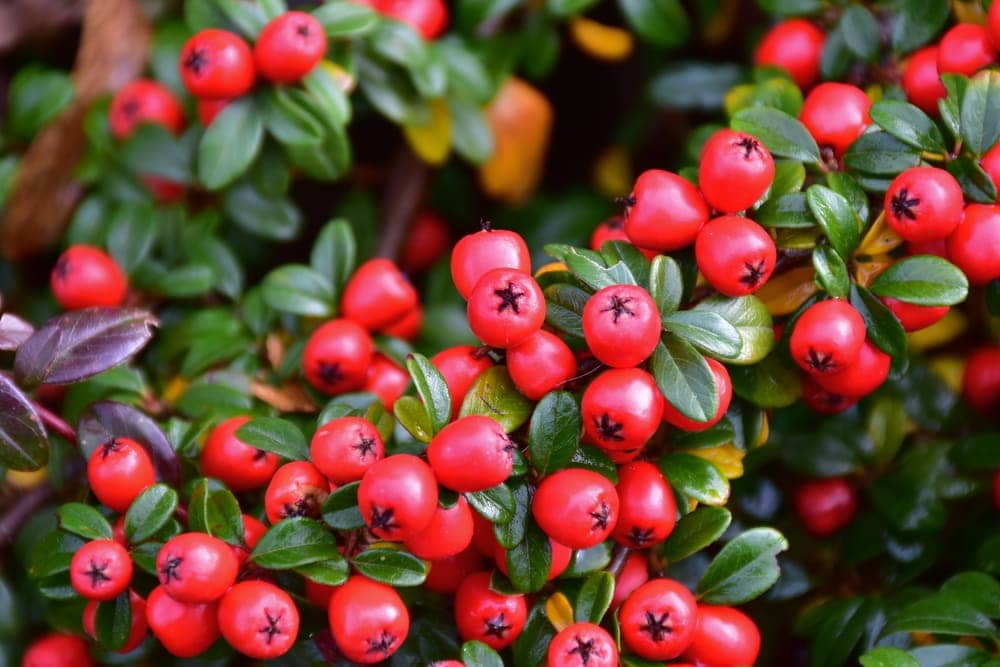
Cotoneaster refers to a large genus of flowering plants that are technically part of the rose family. These plants were traditionally found throughout the temperate regions of Europe, Africa, and Asia, though you can now find them in North America.
Almost all cotoneaster plants feature berries and leaves that contain cyanogenic glycosides. Even though cotoneaster plants generally have low levels of these compounds, consuming too many berries can lead to kidney, liver, or heart failure. This is particularly true among young children.
Additionally, cotoneaster berries are believed to be toxic to dogs. Although a dog that eats these berries will usually only experience mild digestive problems, eating large quantities of berries could lead to severe health issues among canines.
24. Bitter Almonds
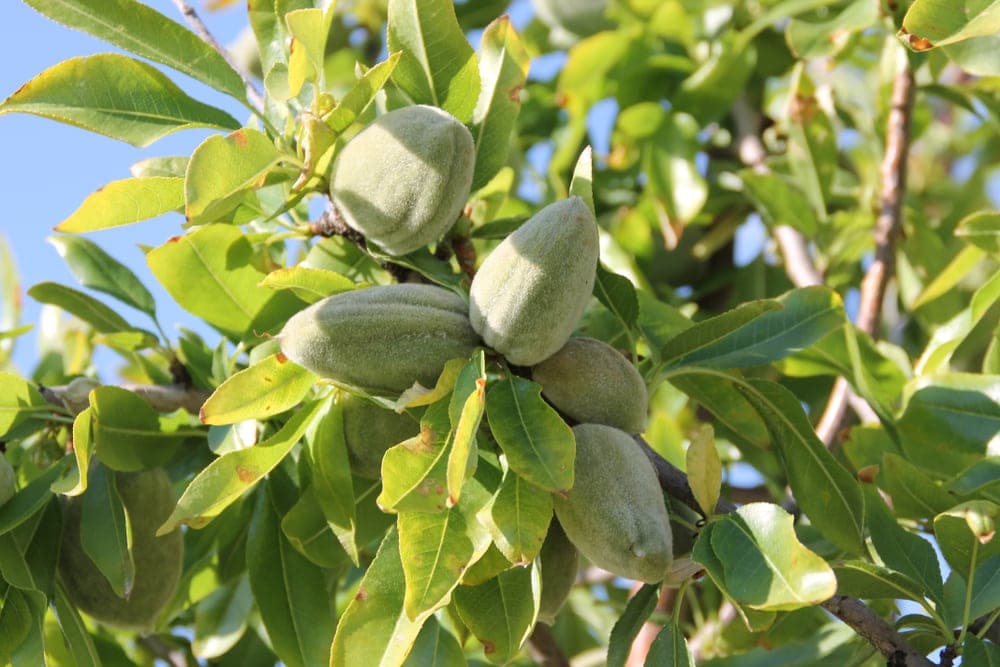
Okay, we know what you're thinking: "Almonds? I love almonds and I eat them every day. How could they be toxic?"
Well, technically there are two major varieties of almonds: sweet and bitter. Sweet almonds are the type that many of us love to eat because they're nutty and delicious. Bitter almonds (Prunus dulcis var. amara), on the other hand, are actually somewhat toxic.
Bitter almonds were once fairly common, but we humans have selectively cultivated the sweeter variety. We still use bitter almonds to this day, but that's mostly for making almond extracts or certain almond pastes.
The problem with bitter almonds is that they have high concentrations of glycoside amygdalin that breaks down into hydrogen cyanide when eaten—not good. Eating approximately 50 of these almonds can cause death, while it's believed that only 6 to 10 bitter almonds are needed to cause health issues.
Thankfully, bitter almonds seem to become edible after they've been cooked. Research shows that the cyanide content of bitter almonds decreases with heat. But we still don't know the safest way to prepare these nuts. So if you come across an almond tree during your travels, it's best to avoid eating the almonds until you know that they're definitely the sweet variety.
25. Mistletoe

A mainstay of Christmas and yuletide celebrations around the world, the mistletoe is a type of hemiparasitic plant that originated in Europe but has since been introduced to North America. But while the mistletoe is quite festive, it's not a great snack to eat with your eggnog.
There are a number of active substances in mistletoe, including tyramine and phoratoxin, which can cause vomiting, nausea, and cardiac arrest.
But there are actually 1,500 different mistletoe species, each of which has varying levels of these toxins. This makes identifying particularly poisonous mistletoe plants very difficult.
In fact, it's believed that American mistletoes are less toxic than their European counterparts. But with all those potentially nasty side effects to worry about, it's probably better not to taste the mistletoe at your next holiday gathering.
26. Poison Ivy
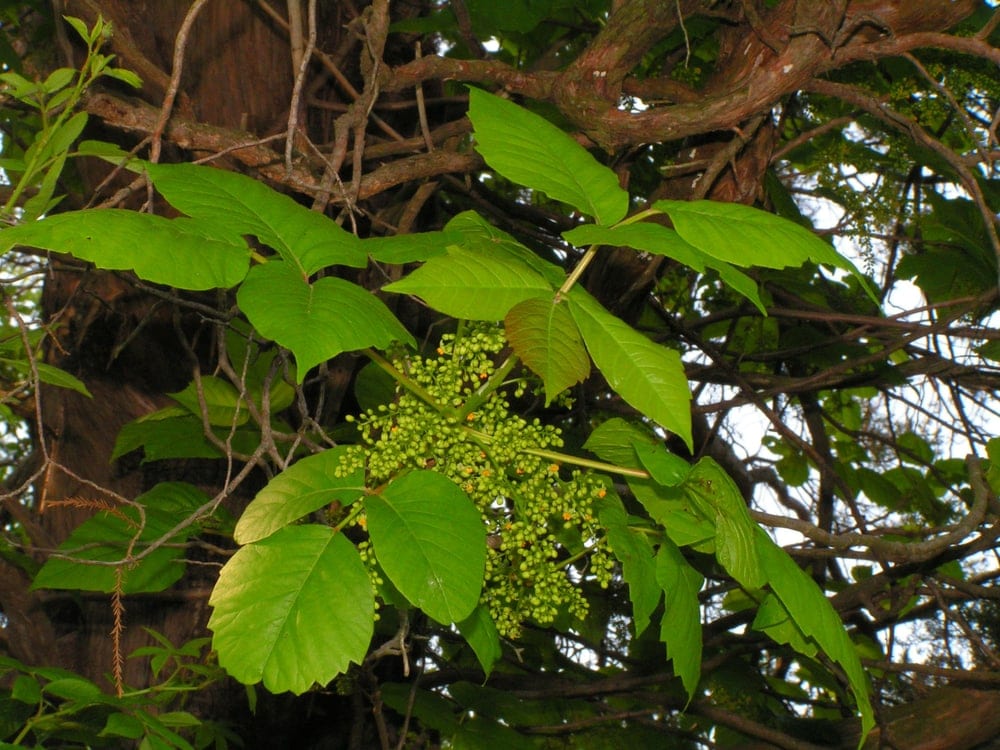
If you live in parts of Asia or eastern North America, poison ivy (Toxicodendron radicans) is just a fact of life. These flowering ivies are known for causing some nasty rashes for all those who have the unfortunate experience of brushing up against one of them on the trail.
But few people realize that poison ivy also has berries. Technically, poison ivy berries are drupes, not berries, but they look similar enough.
As is the case with the stems, leaves, and roots of the poison ivy, the berries of this plant are also toxic. They, too, contain urushiol, which is the compound that leads to rashes when you touch poison ivy.
Although there aren't many studies on what happens if you eat urushiol, we do know that inhaling the smoke of burning poison ivy plants can cause rashes to appear in your airway. This on its own is exceptionally painful and can cause respiratory arrest. Therefore, avoiding contact of any kind with any part of the poison ivy plant—including the berries—is ideal.
27. Manchineel Tree
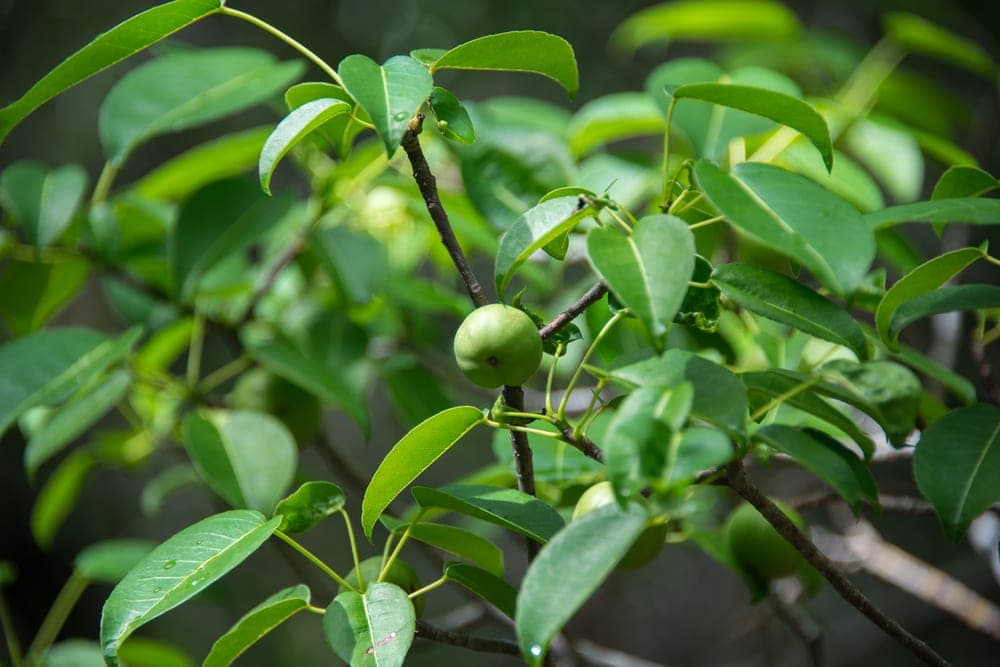
The manchineel tree (Hippomane mancinella) is arguably one of the most toxic trees in the world. Also called the manzanilla de la muerte in Spanish, which translates to the "little apple of death," the manchineel's green fruits roughly look like tiny unripe apples.
Unlike apples, however, the manchineel tree's fruit contains a milky white sap that features the toxic compound phorbol. Consuming or even just touching this compound can lead to severe pain and death, though few fatalities have been reported.
For the most part, the manchineel tree is found in tropical areas, including in much of the Caribbean and Central America. In these regions, many manchineel trees are labeled with warning signs to protect unsuspecting foragers. However, caution is needed whenever eating apple-like fruits in the wild as they may not be what they seem.
28. Holly
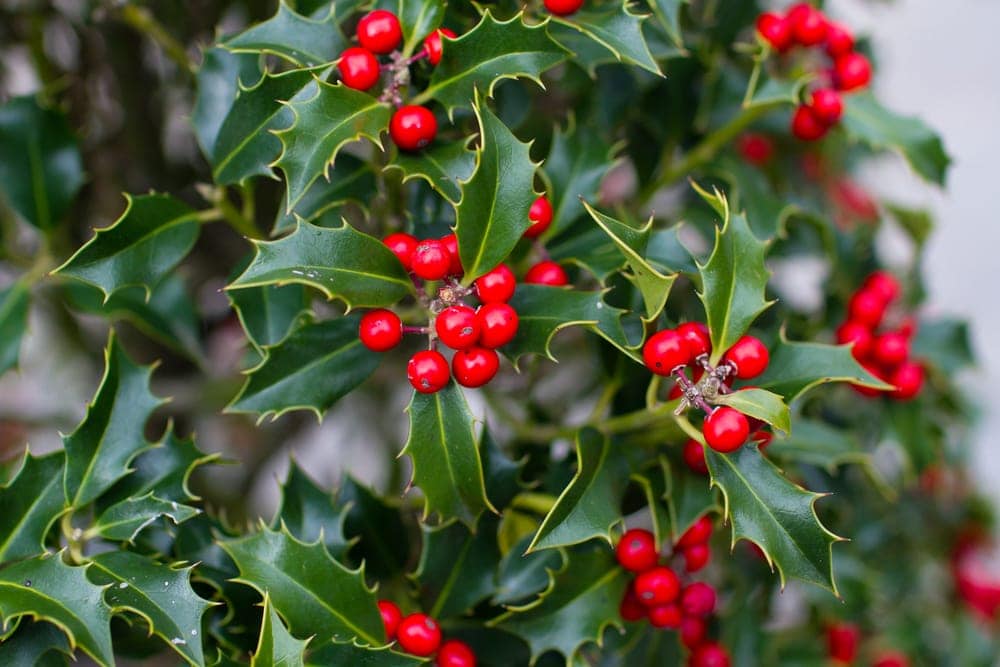
Holly is another Christmas symbol that's known for being a festive addition to any wintery gathering. Like mistletoe, however, holly is also highly toxic, so it's best as a decoration, rather than as a holiday snack.
While holly is a beautiful decorative plant, the berries of the holly plant genus Ilex (there are about 480 species in the genus) are all toxic. They contain a number of different compounds, including theobromine, rutin, quercetin, and chlorogenic acid.
For the most part, ingesting holly berries leads to diarrhea and vomiting, though they can also lead to intestinal problems. Eating even a few holly berries can lead to health problems in children. Thankfully, the prickly leaves of the holly plant usually dissuade kids from eating these berries, but it's important to keep in mind while hiking or enjoying a yuletide celebration.
29. Elderberry
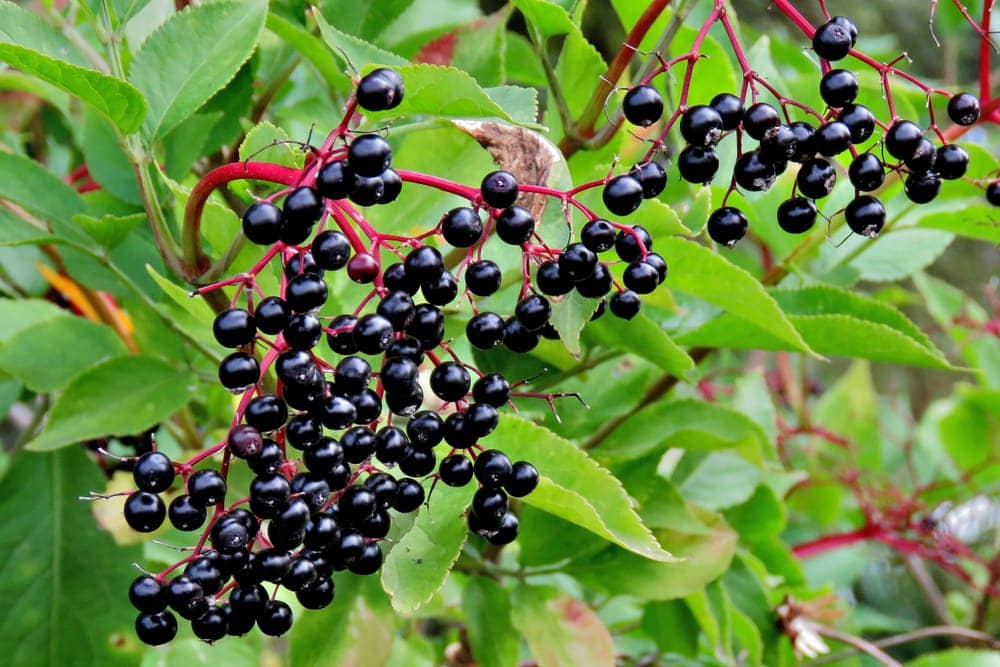
Although elderberry is a delicacy and one of the most commonly used medicinal plants on the planet, it's technically toxic. Yep, that's right. When eaten raw, elderberry's bark, leaves, and berries can cause health problems.
That's because elderberries naturally contain lectins, which are a type of protein that can cause stomach issues. Additionally, elderberries contain cyanogenic glycosides which can cause cyanide poisoning, just like in bitter almonds.
The good news is that cooked elderberries don't contain these compounds, so it's generally not a problem to eat the berries with proper preparation. Either way, the bark, branches, and leaves of elderberries don't lose their toxic compounds when cooked, so hikers should avoid eating these during their travels.
30. Wild Cherry
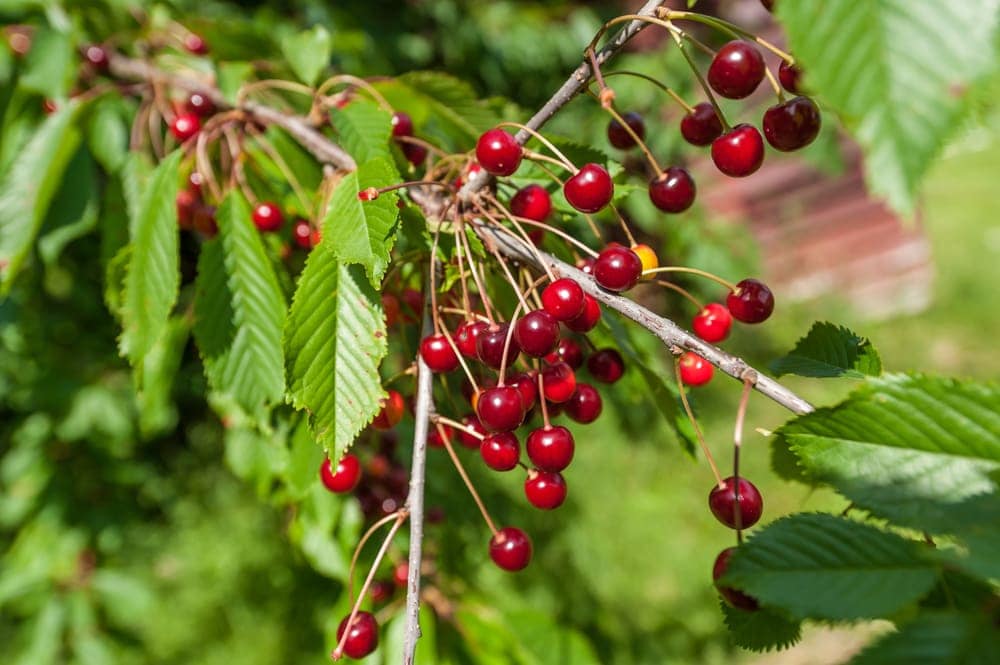
Last but not least on our list, we have the wild cherry (Prunus serotina). Also called black cherry, the wild cherry tree is a deciduous tree that's found throughout the Americas.
While it shares part of its name with the tasty cherry that many of us enjoy, the wild cherry's leaves are highly toxic. The wild cherry tree leaf contains hydrocyanic acid and cyanogenic glycosides, which can release cyanide when ingested. This can be fatal if eaten in large quantities.
Fatalities associated with wild cherry in humans aren't very common. However, livestock and pets are common victims of the wild cherry due to the fact that they sometimes eat the tree's poisonous leaves. Therefore, hikers should keep a close eye on their pets while venturing down the trail.
How to Identify Common Poisonous Berries (North America Edition)
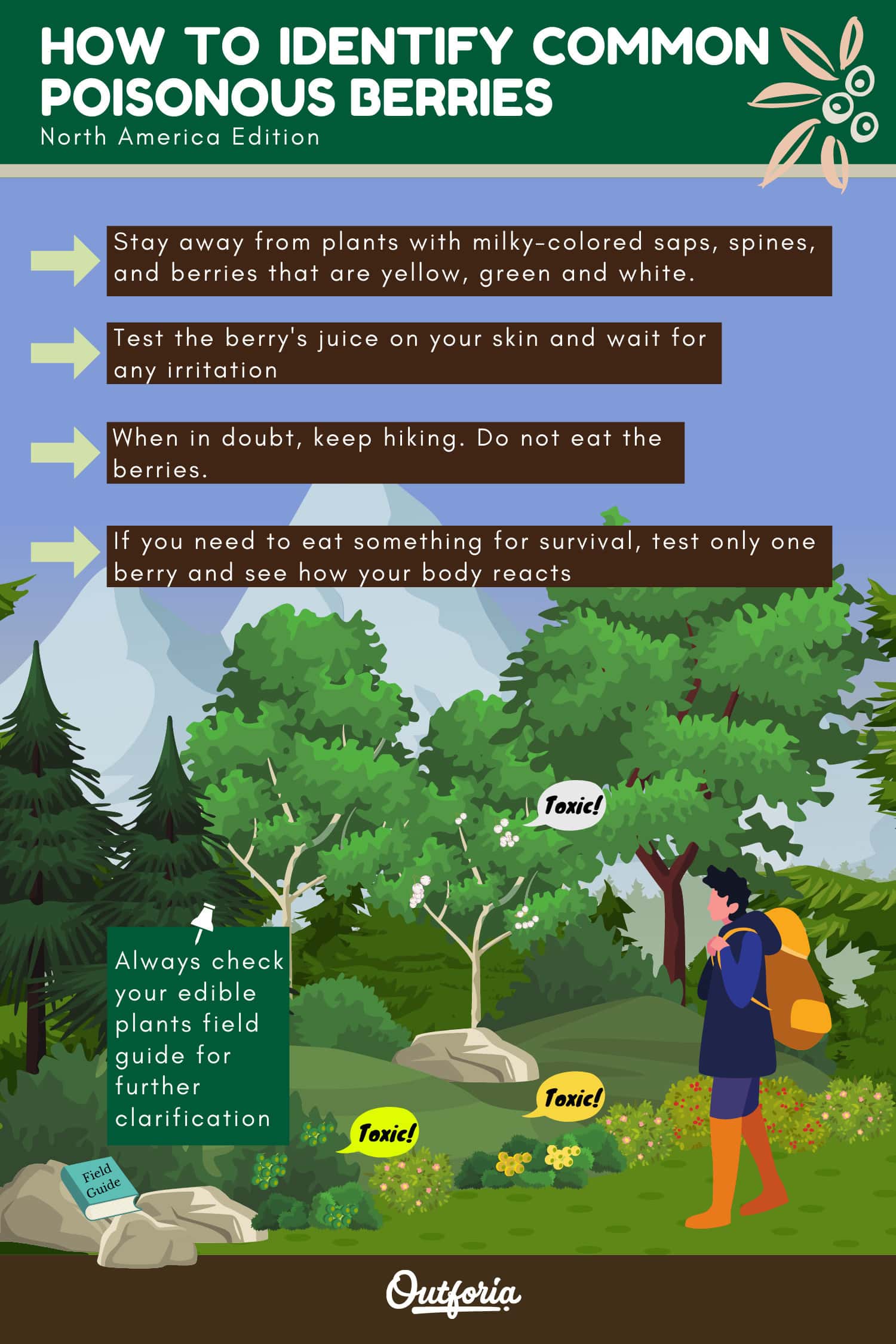
At this point, we've discussed 30 of the most poisonous berries, fruits, mushrooms, and herbs on the planet. But, how exactly can you identify common poison berries in the field?
The reality is that there's no single universal method that you can use to identify toxic plants during your hikes. Many toxic plants and berries look eerily similar to their non-toxic counterparts, so there's no shortcut to proper plant identification.
As we've mentioned earlier, the best way to forage is with a healthy dose of caution. If you're not 100% certain of what you're eating, don't eat it! It's better to miss out on a snack than to land in the hospital.
However, there are a few steps you can take to minimize your risk of eating a toxic plant. These steps aren't exhaustive and they won't protect you from everything, but they can be a helpful tool in your plant identification toolbox.
Also, keep in mind that there are thousands of plant species out there, so we can't speak to proper plant ID on all of them. So these tips are for North American plants only.
Without further ado, here are some key steps you can follow to identify toxic plants:
- Look For Common Features of Toxic Plants – Many toxic plants have common features, like milky-colored saps, spines, and berries that are concealed in pods or bulbs. Most toxic berries are also white, green, or yellow in color, so these should be avoided unless you're certain that something is edible. Of course, you can find blue, black, and red berries that are toxic, though they are less common. Check your edible plants field guide for further clarification.
- Test the Berry Juice for Toxicity – Before eating a berry, consider testing the berry's juice on your skin. Smashing up a few berries and placing the juice on your arm can let you know if the juice's compounds are going to cause any health issues. After waiting for about 10 minutes, you can try putting the juice on your lips to see if you have any further reaction. If not, the berry may not have any toxic compounds, but there is no guarantee. Again, this strategy is not foolproof, but it can be helpful.
- When In Doubt, Keep Hiking – If your plant identification and berry testing strategies left you feeling uncertain about the toxicity of the plant in front of you, it's best to keep moving down the trail. Even the most innocuous-looking berry or mushroom can be severely toxic.
- Try A Test Berry – In emergency situations where you absolutely need to eat something, start with only 1 berry or a small portion of a plant leaf at a time. For all but the most toxic of plants and fungi, a small portion isn't enough to cause serious health issues. Therefore, starting with just 1 berry and waiting for about 20 to 30 minutes can give you an idea if you're going to have an adverse reaction. Also, keep in mind that if a berry tastes terrible, it's probably toxic.
We might sound like a broken record at this point, but we need to say it again: do not eat any plants that you have not identified with 100% certainty.
Except in true emergency situations, that handful of berries is not worth the risk. If you want to forage for fun, bring an edible plants guide for your area and only eat plants that you are completely certain of.
What to Do If You Eat a Toxic Plant
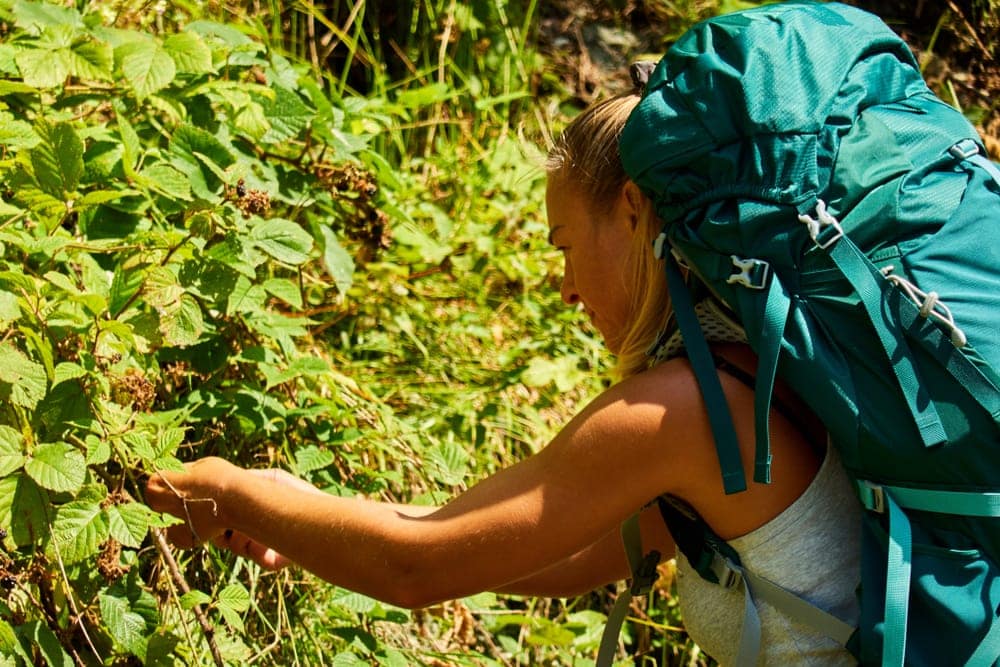
Hopefully, your astute plant ID skills and cautious approach to foraging have prevented you from accidentally eating a toxic plant that looks like food. In the unfortunate instance that you do eat something that's not edible, it's important that you quickly get to medical care.
Should you come into contact with a poisonous plant while hiking, do the following:
- Stay Calm – It might sound cliché, but no one has ever achieved anything from panicking in an emergency.
- Take Photos – If you can, take photos of what you ate. Doing so may help with plant identification by poison control or the hospital. Do not bring the berries, fungi, or plants with you to the hospital. Bringing these substances to the hospital can be dangerous for you and medical providers.
- Get To Medical Care – Even if the amount of toxic berries that you ate is relatively small, your best bet is to get to medical care as soon as possible. Everyone reacts differently to different substances, so you want to be around medical professionals if you were to have an adverse reaction to a toxic plant. The faster you can get to medical care, the better, but don't over-exert yourself or get lost in the process.
- Provide Supportive Care – Should you be tasked with caring for someone in the backcountry that is having an adverse reaction to toxic berries or plants, you may need to provide supportive care to that person. Doing so is only appropriate for people with prior medical or wilderness medicine training. Supportive care in these wilderness situations usually means conducting a complete patient assessment and coordinating an evacuation.
The best treatment for toxic plants is prevention. In an ideal world, caution would prevent you from ingesting a toxic plant. When in doubt, don't eat an unidentified plant. You'll thank yourself later.
Toxic Plants FAQs
Here are our answers to some of your most commonly asked questions about toxic plants:
How do you identify a poisonous plant?
There is no fool-proof way to identify a poisonous plant in all situations. As a general rule, you should avoid eating plants with white, green, or yellow berries as they tend to be toxic. However, there is no substitute for a quality edible plant guidebook and good plant identification skills when foraging.
What is the most toxic plant?
There are many plants that could be labeled as the most toxic plant in the world. The castor bean plant is arguably one of the most poisonous, but others include the manchineel tree, rosary pea, angel's trumpets, and the doll's eyes.
What plant can kill you if you touch it?
Monkshood is one of the few plants that has the power to kill you if you touch it. Death is not a common result of touching monkshood, but the plant itself is highly toxic. Touching monkshood is more likely to result in severe illness, but fatalities can happen.
Are plants with thorns poisonous?
Not all plants with thorns are poisonous, but some are. Most nightshades, which are generally quite toxic, do have thorns. But there are many other thorny plants, like blackberries, that are absolutely delicious and are not toxic
Source: https://outforia.com/toxic-plants/
Post a Comment for "What Are Some Poisonous Plants That Look Like Yew Berries Toxic Blueblack Berries"